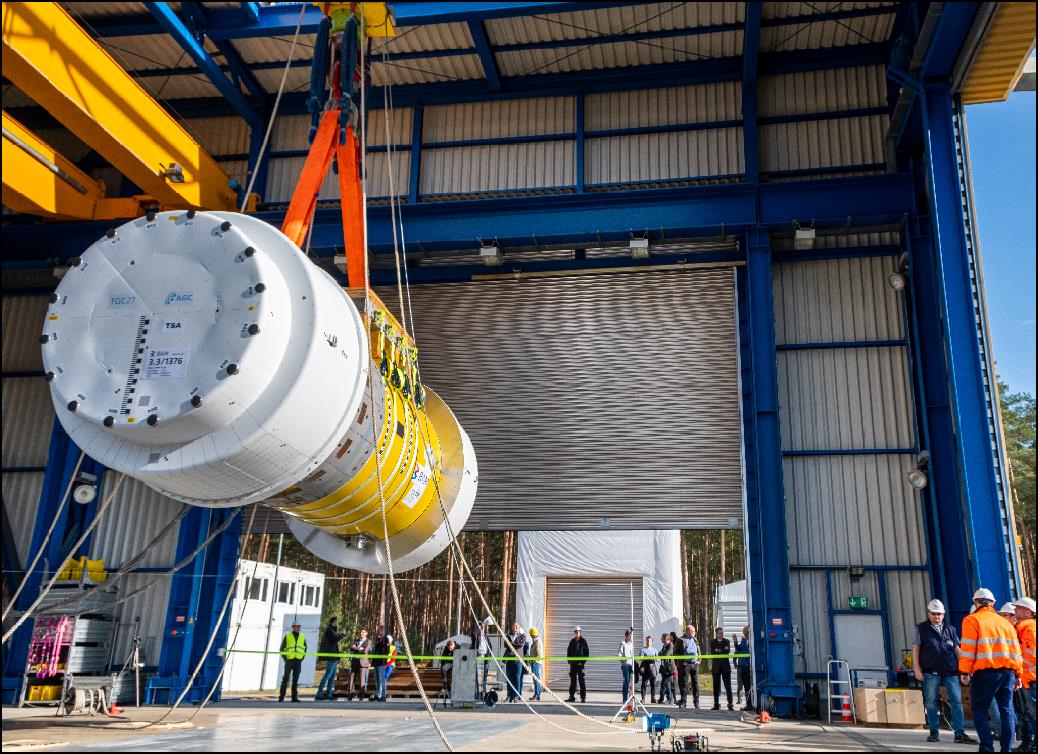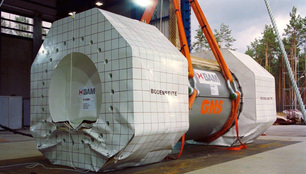
TGC27 transport and storage container (developed by AGC, a private partnership of Orano NPS and Gesellschaft für Nuklear-Service mbH) suspended from the drop tower on the TTS.
Source: BAM
As part of Germany's phase-out of civil nuclear energy use, nuclear waste management represents a major challenge - both for current and future generations. In order to protect people and the environment from radioactive pollution, the radioactive waste from various branches of industry must be sealed and contained indefinitely. This is primarily done with the help of special transport and storage containers, which must satisfy the highest safety standards.
The fact that storage will be required to last a considerable amount of time presents a particular challenge. This must be taken into account when selecting a site for the construction of a final repository specifically designed for high-level radioactive waste. While the repository site is being identified, interim storage facilities have to operate much longer than originally planned. They need to do so without the safety level of the storage facility deteriorating over time and with subsequent transports still being possible while fulfilling high safety standards.

TGC27 transport and storage cask (developed by AGC, a private partnership of Orano NPS and Gesellschaft für Nuklear-Service mbH) before drop testing on the Test Site for Technical Safety.
Source: BAM
The safe storage and disposal of various low- and intermediate-level radioactive waste from the decommissioning and dismantling of nuclear power plants must also fulfil safety-relevant requirements - the same applies to waste from research, medicine, and materials testing. They all have to be transported, stored and disposed of safely.
BAM has been active in the field of safety assessment and approval of transport and storage containers for radioactive materials for several decades and has extensive expertise in this area.
Testing, assessment and research for the safe containment of radioactive materials
BAM develops, for example, validated assessment methods to verify the operational, accidental and long-term safety of materials, components, containers, container inventories and building structures. Test facilities at BAM's Test Site for Technical Safety at Horstwalde enable a wide range of component tests, including full-scale drop and fire tests with containers of up to 200 tonnes. Various measurement techniques, data acquisition and data evaluation systems are available to analyse the tests. In addition, BAM develops simulation and forecasting models for the long-term behaviour as well as mechanical and thermal accident scenarios. On the basis of the data obtained, the underlying calculation approaches are validated and improved.
BAM also works at a national and international level to further the development of regulations and norms in order to establish and refine reliable safety standards.

Calorimeter test (test sample from the Gesellschaft für Nuklear-Service mbH) in the fire test stand at the BAM Test Site for Technical Safety.
Source: BAM
Our current research focuses on the long-term behaviour of container components and systems for extended interim storage with subsequent transportation, ageing management, the fire behaviour of wood-filled impact limiters, the requirements for final disposal containers and the analysis and evaluation of the integrity of final storage closure buildings using innovative ultrasonic testing methods.
Services and Expertise in the Field of Nuclear Waste Disposal
Our expertise includes:
- Safety assessment of transport and storage containers for radioactive materials
- Mechanical tests using full-scale test facilities to assess hypothetical accident scenarios
- Thermal tests using full-scale test facilities to assess severe fire scenarios
- Safety and suitability assessments of materials and containment systems for the transport and storage of radioactive materials
- Experimental long-term investigations into aging effects on container materials, components, and systems (e.g. sealing systems)
- Investigation of microbially influenced corrosion processes on container materials under disposal conditions
- Helium leak tests on sealing systems
- Development of regulations, codes and standards including participation in national and international committees
- Numerical analyses of mechanical (static and dynamic) and thermal load scenarios under operational and accidental conditions for container components and systems
- Non-destructive testing of structures, structural components, and building materials for interim storage and final disposal facilities above and below ground




